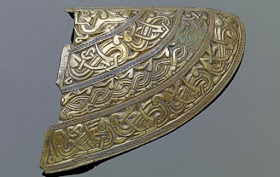is attributed to King Rædwald of East Anglia (~ 599-624) and with good reason. In any case it's Anglo-Saxon and was buried around 625.
Here are two pieces of the Staffordshire Hoard.
Let's take a look at the dragon designs.
- In the Staffordshire Hoard the dragons are real dragons with heads and feet.
- On the Sutton Hoo Helmet the ornaments are mere patterns, which have plausibly been derived from winding dragons, but they show no anatomical details.
- In the Stafforshire Hoard the dragon heads are very primitively shaped, exuding a mythical vibe.
- On the Sutton Hoo Helmet the dragon heads on the eyebrows are somewhat more elaborately sculpted, exuding a vibe more akin to a fairy tale.
Considering the Anglo-Saxon kingdoms to be culturally comparable, or at least Mercia and East Anglia, that is to say forming one general Anglo-Saxon culture, we should be save if we ascertain that the Stafforshire Hoard consists of older pieces than the Sutton Hoo Helmet, if the former is of Anglo-Saxon, or more precisely Mercian, origin for
- naturalism (in principle, i.e. caring for details) precedes abstraction,
- myth precedes fairy tale and
- simplicity precedes elaboration.
But what does that leave us with?
That the Sutton Hoo Helmet and the Stafford Shire Hoard belong to similar, but not to the same culture, and that the culture of the Sutton Hoo Helmet was more advanced.
And concretely that leaves us with two possibilities, namely
- Mercia sucked big time as far as the arts were concerned or
- the so called Great Heathen Army wasn't heathen at all and the Mercians burried the proof for it for propagandistic reasons.


